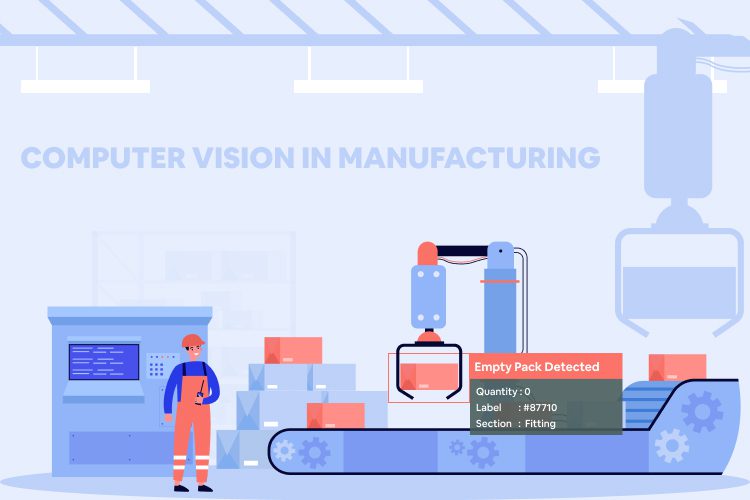
DeepLobeJanuary 27, 2021Computer Vision , Uncategorized
Though various forms of computer vision (A.K.A machine vision) are used in manufacturing for decades, the recent advancements in machine learning and computer vision are increasing the demand and need for computer vision applications on the shop floor. According to Grand view research, the global market for computer vision technology is expected to reach USD 19.1 billion by the year 2027 and the market growth rate in the manufacturing sector is expected at a CAGR of 7.6% from 2020 to 2027.
Introduction to Machine Vision
According to AIA (automated image association), machine vision systems possess all the industrial and non-industrial applications in which a set of software and hardware components are provided with the operational guidance to capture, analyze, and process images for the execution of their functionality.
Higher quality, increased productivity, production flexibility, less machine downtime, lower capital equipment costs, fewer production costs, scrap rate reduction, inventory control, reduced floor space are a few applications of computer vision that are driving demand for this technology. Computer vision in manufacturing processes, analyzes, and measures various attributes for decision making. Greater accuracy, high robustness, high mechanical and temperature stability makes this technology one of the advanced and reliable tools to inspect the manufacturing process. Machine vision can also perform tasks related to objective measurements for effective strategic decision-making.
We further attempted to discover where you can use computer vision in the manufacturing industry and how it helps in meeting strategic objectives.
Computer Vision in Manufacturing-Use Cases Overview
Computer vision technology is undergoing a relentless transformation. The technological advancements in computer vision are optimizing the processes and reducing the risk for human errors. In reality, the applications of machine vision in manufacturing are almost limitless. And here we showcased a few vital examples of computer vision and machine learning.
1. Vision-guided robots
It is one of the most common applications of computer vision in manufacturing. This computer vision system is used for the detailed positioning of objects on the production line. The system identifies the precise location of an object or a tool and sends the signal to the robot to pick and place that object or tool.
2. Anomaly detection
An anomaly detection algorithm processes the new images with the existing data sets to find out the anomalies and prevent uncertain situations in the manufacturing site and on the production shop floor.
3. Barcode and OCR reading
Barcode is the identification code printed on every object for effective machine reading. And the same code is detected by using OCR (optical character recognition) tools to assemble the various parts of an engine or various machinery required during the manufacturing process.
- Engine Assembly
To control the process of engine assembly MV system is used to capture images of barcodes or OCR. barcode provides the information about various parts to be assembled during the process and OCR generates a unique identification number for every engine part.
- Description of system operation
During the manufacturing process, the component which has to be inspected is placed on the inspection table and the various images are taken to the MV system to identify the presence of components.
4. Process control in manufacturing
When a large number of items need to be inspected on a production line, Computer vision can be the vital technology that can help manufacturers in automating the inspection process by scanning the objects or finished products to meet the acceptance criteria. Using computer vision in manufacturing can control processes like:
– Identifying the defective products.
– Track whether the product has desired architecture, color, length, and width.
– Packing inspection.
– The system can inform the inspection manager under charge to halt the production cycle.
5. Labeling, tracking, and tracing
When a product is mislabeled or misplaced, it’s just not a manufacturer losing the production time and cost, it’s more about an end consumer losing the trust in the brand. To meet the objective of making your customers happy, integrating the customer vision into the current operating system can make a great impact. Forrester’s analysis also suggests that companies can create new business outcomes by blending in customer vision technologies in the manufacturing business.
How can manufacturers utilize computer vision in meeting strategic goals?
For any manufacturing organization maintaining higher quality, increased productivity, flexibility in the production process, reduced machine downtime, and cost of setup, reduction in scrap rate, inventory control, are the strategic goals. Machine vision applications like operation guidance, part or product identification, gauging, and inspection can outperform human vision and excel at speed, accuracy, repeatability. So incubating these automation techniques can help manufacturers in meeting the strategic goals by attaining:
- Machine vision system to perform repetitive tasks.
- Improve production flexibility by prior operation verification, measurement and gauging, and robot assistance.
- By programming changeovers in advance to reduce machine downtime.
- Adding vision to a machine improves its performance and avoids obsolescence.
- The computer vision system can identify the flaws in the production line at a faster speed and accuracy.
- Vision system to perform security and surveillance operations on the shop floor.
The application of machine vision continues to increase as research and development in the field advances. Machine vision provides additional safety and operational benefits by reducing human involvement in a manufacturing process.
Machine vision or computer vision is the application of the automatic extraction of information from digital images. The application of this technology ranges from image processing to quality inception and control. Today, most manufacturers show interest in automated machine vision to enhance business outcomes because the system is objective-oriented and works continuously. Moreover, a machine vision system can work around the clock to save money and increase profitability.
If you have more questions about computer vision in manufacturing or need help with a CV-based solution, contact our experts today!
